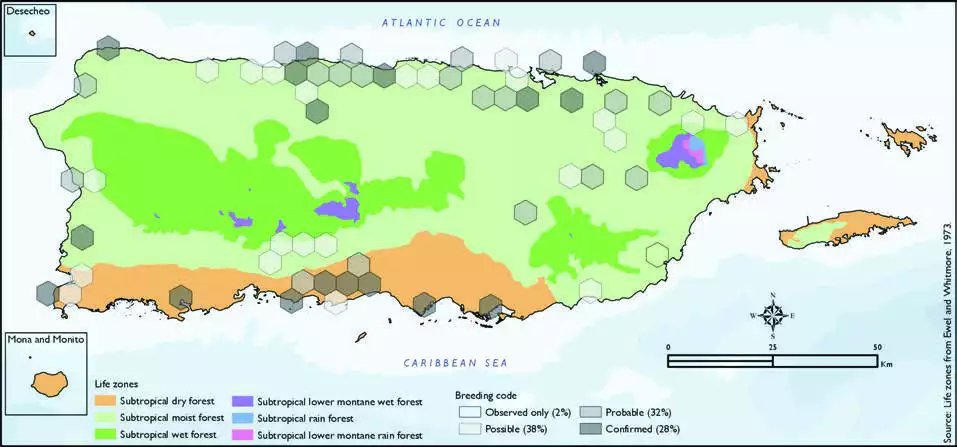Monk Parakeet
Description
The monk parakeet (Myiopsitta monachus), also known as the Quaker parrot, is a species of true parrot in the family Psittacidae. It is a small, bright-green parrot with a greyish breast and greenish-yellow abdomen. Its average lifespan is 20–30 years. It originates from the temperate to subtropical areas of Argentina and the surrounding countries in South America. Self-sustaining feral populations occur in many places, mainly in North America and Europe.
Distribution & Habitat
The Monk Parakeet is native to south-central South America, and
in the West Indies it has been
introduced to Puerto Rico, the
Cayman Islands, Guadeloupe,
and The Bahamas (Raffaele
and others 1998), as well in
major cities of North America
and Europe (del Hoyo and
others 2013). In Puerto Rico, it
is a common resident along the
coastal plain and urban areas
(Falcón and Tremblay 2018) and
can be found in coastal habitats
and palm groves (Raffaele and
others 1998), farms, gardens, and city parks (Oberle 2018). The
atlas fieldwork yielded a total of
76 records within 60 hexagons
or 13 percent of the 479 total
hexagons (see map). Of the 60
hexagons where this species
was found, breeding met the
atlas definition of confirmed in
28 percent (17) of the hexagons,
probable in 32 percent (19), and
possible in 37 percent (22), while
the species was observed in 3
percent (2) of the hexagons but
without evidence of breeding
(see map).Monk Parakeet distribution. The map shows the highest breeding code by hexagon and overlaying the ecological life zones in
Puerto Rico. Note: percentages may not total 100 due to rounding. 187Monk Parakeet/Perico Monje

Breeding Habits
The Monk Parakeet builds a large communal nest made of
sticks, often placed at the base
of palm fronds (Oberle 2018,
Raffaele and others 1998). Atlas
results show that this species
breeds throughout the year
with the most breeding activity
from March to May (see chart).
Overall, the breeding activity
peaks during April and May,
and it mostly takes place within
the subtropical moist forest life
zone (see chart). Results (see
table and map) show that this
species breeds mostly within the
subtropical moist forest life zone (78 percent of the hexagons) and
also within the subtropical dry
forest life zone (22 percent of
the hexagons).
Conservation
The current global population trend of the Monk Parakeet has
not been quantified or assessed,
but the species is described
as common and common to
abundant (del Hoyo and others
2013, Stotz and others 1996),
and the population is suspected
to be increasing due to the
creation of new suitable habitat
(del Hoyo and others 2013).
This species is currently listed as a species of least concern by
the IUCN (BirdLife International
2018). The parakeet has been
increasing in numbers in Puerto
Rico and has expanded it range
from the urban locations where
originally introduced (Falcón
and Tremblay 2018). Locally, this
species is not listed in any of the
threatened categories of PRDNER
and USFWS. In Puerto Rico, the
Monk Parakeet has a protected
habitat in land of 10 percent or
141 km2 of the total area covered by the hexagons where evidence
of breeding was found for this
species (1387 km2).
Related Species
Family:
parakeet